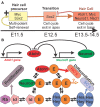Opportunities and limits of the one gene approach: the ability of Atoh1 to differentiate and maintain hair cells depends on the molecular context
- PMID: 25698932
- PMCID: PMC4318345
- DOI: 10.3389/fncel.2015.00026
Opportunities and limits of the one gene approach: the ability of Atoh1 to differentiate and maintain hair cells depends on the molecular context
Abstract
Atoh1 (Math1) was the first gene discovered in ear development that showed no hair cell (HC) differentiation when absent and could induce HC differentiation when misexpressed. These data implied that Atoh1 was both necessary and sufficient for hair cell development. However, other gene mutations also result in loss of initially forming HCs, notably null mutants for Pou4f3, Barhl1, and Gfi1. HC development and maintenance also depend on the expression of other genes (Sox2, Eya1, Gata3, Pax2) and several genes have been identified that can induce HCs when misexpressed (Jag1) or knocked out (Lmo4). In the ear Atoh1 is not only expressed in HCs but also in some supporting cells and neurons that do not differentiate into HCs. Simple removal of one gene, Neurod1, can de-repress Atoh1 and turns those neurons into HCs suggesting that Neurod1 blocks Atoh1 function in neurons. Atoh1 expression in inner pillar cells may also be blocked by too many Hes/Hey factors but conversion into HCs has only partially been achieved through Hes/Hey removal. Detailed analysis of cell cycle exit confirmed an apex to base cell cycle exit progression of HCs of the organ of Corti. In contrast, Atoh1 expression progresses from the base toward the apex with a variable delay relative to the cell cycle exit. Most HCs exit the cell cycle and are thus defined as precursors before Atoh1 is expressed. Atoh1 is a potent differentiation factor but can differentiate and maintain HCs only in the ear and when other factors are co-expressed. Upstream factors are essential to regulate Atoh1 level of expression duration while downstream, co-activated by other factors, will define the context of Atoh1 action. We suggest that these insights need to be taken into consideration and approaches beyond the simple Atoh1 expression need to be designed able to generate the radial and longitudinal variations in hair cell types for normal function of the organ of Corti.
Keywords: Atoh1; development; hair cells; regeneration.
Figures

Similar articles
-
Neurog1 can partially substitute for Atoh1 function in hair cell differentiation and maintenance during organ of Corti development.Development. 2015 Aug 15;142(16):2810-21. doi: 10.1242/dev.123091. Epub 2015 Jul 24. Development. 2015. PMID: 26209643 Free PMC article.
-
Development in the Mammalian Auditory System Depends on Transcription Factors.Int J Mol Sci. 2021 Apr 18;22(8):4189. doi: 10.3390/ijms22084189. Int J Mol Sci. 2021. PMID: 33919542 Free PMC article. Review.
-
Beyond generalized hair cells: molecular cues for hair cell types.Hear Res. 2013 Mar;297:30-41. doi: 10.1016/j.heares.2012.11.008. Epub 2012 Nov 27. Hear Res. 2013. PMID: 23201032 Free PMC article. Review.
-
Conditional deletion of Atoh1 using Pax2-Cre results in viable mice without differentiated cochlear hair cells that have lost most of the organ of Corti.Hear Res. 2011 May;275(1-2):66-80. doi: 10.1016/j.heares.2010.12.002. Epub 2010 Dec 10. Hear Res. 2011. PMID: 21146598 Free PMC article.
-
Dual role for Sox2 in specification of sensory competence and regulation of Atoh1 function.Dev Neurobiol. 2017 Jan;77(1):3-13. doi: 10.1002/dneu.22401. Epub 2016 Jun 6. Dev Neurobiol. 2017. PMID: 27203669 Free PMC article.
Cited by
-
Frizzled-9+ Supporting Cells Are Progenitors for the Generation of Hair Cells in the Postnatal Mouse Cochlea.Front Mol Neurosci. 2019 Jul 31;12:184. doi: 10.3389/fnmol.2019.00184. eCollection 2019. Front Mol Neurosci. 2019. PMID: 31427926 Free PMC article.
-
The quest for restoring hearing: Understanding ear development more completely.Bioessays. 2015 Sep;37(9):1016-27. doi: 10.1002/bies.201500044. Epub 2015 Jul 24. Bioessays. 2015. PMID: 26208302 Free PMC article. Review.
-
Moving into shape: cell migration during the development and histogenesis of the cerebellum.Histochem Cell Biol. 2018 Jul;150(1):13-36. doi: 10.1007/s00418-018-1677-6. Epub 2018 May 9. Histochem Cell Biol. 2018. PMID: 29744613 Review.
-
Cellular and Molecular Mechanisms of Pathogenesis Underlying Inherited Retinal Dystrophies.Biomolecules. 2023 Feb 1;13(2):271. doi: 10.3390/biom13020271. Biomolecules. 2023. PMID: 36830640 Free PMC article. Review.
-
Sensing External and Self-Motion with Hair Cells: A Comparison of the Lateral Line and Vestibular Systems from a Developmental and Evolutionary Perspective.Brain Behav Evol. 2017;90(2):98-116. doi: 10.1159/000456646. Epub 2017 Oct 9. Brain Behav Evol. 2017. PMID: 28988233 Free PMC article. Review.
References
Publication types
Grants and funding
LinkOut - more resources
Full Text Sources
Other Literature Sources
Miscellaneous

